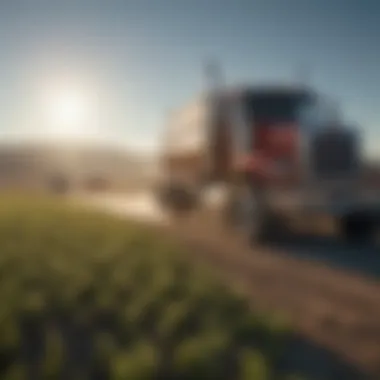Exploring the Resilient Role of Trucks in Yellowstone


Intro
The Yellowstone National Park serves as a remarkable landscape that blends the majesty of nature with the necessity of human intervention. Trucks have played a pivotal role in managing these lands. They are not merely vehicles; they are tools for environmental stewardship, transportation, and support for various park activities. This comprehensive exploration aims to unravel the complexity surrounding the use of trucks in Yellowstone, covering aspects such as their utility in park management, the environmental impacts they cause, their historical significance, and future considerations for sustainable practices.
Understanding the nuances of how trucks function within this unique ecosystem is key for professionals and enthusiasts in agriculture, tourism, and environmental studies. The practical applications of these vehicles extend far beyond conventional perceptions, serving integral purposes in both agricultural endeavors and park maintenance. The role of trucks becomes increasingly significant as Yellowstone navigates the challenges presented by tourism and ecological preservation.
Prolusion to Yellowstone Trucks
The role of trucks in Yellowstone National Park is fundamental in various aspects of park management and conservation. Understanding the function of these vehicles is critical for stakeholders including agriculture farmers and enthusiasts, who seek to grasp the interplay between transportation and the unique ecological landscape of Yellowstone. This section outlines the historical context and operational significance of trucks, offering insights into their contributions to the park's infrastructure and sustainability efforts.
Historical Context
Trucks have a long-standing history in Yellowstone National Park, beginning in the early 20th century when they were introduced to facilitate logistics and enhance accessibility. Initially used for transporting goods and visitors, the advent of vehicles changed the dynamics of park management. In the 1960s, for example, with a rise in visitation, there was a growing need for efficient transport solutions. This expansion brought about changes in the vehicles used, transitioning from simple utilitarian designs to more specialized models that supported diverse park functions. The evolution of these vehicles reflects not only the needs of the park management but also the advancing technology and changing visitor expectations over decades.
Importance in Park Infrastructure
The infrastructure of Yellowstone depends heavily on truck operations. These vehicles are integral to maintenance, logistics, and conservation efforts. Here are several key roles trucks play:
- Maintenance and Repairs: Trucks are essential for transporting tools and personnel to remote locations in the park for maintenance tasks. They reach areas that are otherwise inaccessible, ensuring that the park's public facilities stay operational and safe for visitors.
- Resource Management: They are involved in transporting materials necessary for resource management, including fire suppression equipment and wildlife monitoring tools. The availability of trucks ensures that park personnel can respond efficiently to emergencies, such as wildfires or wildlife interventions.
- Visitor Services: Trucks provide vital services for park visitors. From guided tours to shuttle services, they enhance the visitor experience. Buses or 4x4 vehicles often help in transporting guests through different terrains, emphasizing the trucks' versatility in navigating Yellowstone's varied landscape.
"In the rugged terrain of Yellowstone, trucks are the quiet backbone that supports both conservation efforts and visitor satisfaction."
In summary, trucks are not just vehicles; they are essential components of Yellowstone's operational framework. Their historical significance and practical importance lay the groundwork for understanding their role in future sustainability initiatives within the park.
Types of Trucks Used in Yellowstone
Understanding the types of trucks utilized in Yellowstone National Park is essential for grasping how park management and conservation efforts operate. Each type serves a unique purpose, and their specifications are designed to meet the challenges posed by the park's diverse environments. The composition of these vehicles contributes significantly to operations, ranging from everyday tasks to specialized missions aimed at preserving the wild landscape.
Standard Utility Trucks
Standard Utility Trucks form the backbone of Yellowstone's vehicle fleet. These trucks are versatile and capable of handling various tasks that park staff encounter daily. They are typically equipped with all-terrain capabilities to navigate the park's rugged terrain. Their utility is crucial for transporting staff, equipment, and supplies across different locations in the park.
The durability and robustness of these trucks allow them to perform efficiently in adverse conditions. Features such as enhanced suspension and all-wheel drive ensure they can operate on gravel, dirt roads, and even snow-covered areas during harsh winters. The operational efficiency of Standard Utility Trucks promotes the effective implementation of park management strategies.
Specialized Service Vehicles
Specialized Service Vehicles cater to specific operational needs within Yellowstone. These units are customized for particular tasks such as maintenance, emergency response, and wildlife monitoring. For instance, vehicles designed for wildlife management are equipped with appropriate technology to assist in tracking animal populations and their behaviors.
Maintenance trucks carry tools and equipment necessary for maintaining park facilities and landscapes. They can also be outfitted with waste disposal units to enhance the park’s cleanliness and sustainability efforts. The importance of these vehicles extends beyond simple transportation; they play a pivotal role in ensuring the continuation of park operations.
Towing and Recovery Trucks
Towing and Recovery Trucks are essential for managing incidents involving vehicles disabled within the park’s boundaries. The vast and isolated areas of Yellowstone can pose risks, making these trucks vital for quick response to emergencies. Their design often includes heavy-duty towing equipment capable of hauling vehicles out of difficult situations.
In addition to assisting park staff, Towing and Recovery Trucks help ensure visitor safety. By maintaining an efficient response system to vehicle troubles, the overall visitor experience can be heightened. Their presence reinforces Yellowstone's commitment to safety and accessibility, crucial elements for a national park that experiences millions of visitors annually.


Role of Trucks in Environmental Management
Trucks play a critical role in managing the delicate balance of the Yellowstone ecosystem. They serve multiple functions, all aimed at preserving the park's unique environment. Their utility is undeniable when it comes to the logistical challenges of environmental management. As custodians of this natural heritage, park authorities deploy trucks for various essential services.
Wildlife Management
The management of wildlife is paramount in Yellowstone, and trucks are indispensable in this effort. These vehicles are employed to transport biologists and wildlife specialists during field studies. Often, they carry equipment necessary for monitoring animal populations, tracking movements, and assessing habitat conditions. For instance, park rangers utilize trucks to transport tranquilizers and other veterinary tools for treating injured wildlife.
In addition, trucks are vital for relocating animals when their population density becomes a concern. This practice helps in minimizing human-wildlife conflicts, ensuring that both park visitors and wildlife can coexist without adverse effects. Furthermore, they enable quick response times for rescuing injured or stranded animals, reinforcing their invaluable role in the park’s conservation efforts.
Fire Control Efforts
Fire is a natural part of many ecosystems, including Yellowstone. However, when fires become uncontrolled, they can threaten both wildlife and human safety. Trucks are used extensively in fire control efforts, both in preparing for and combating wildfires. They are equipped with firefighting equipment and are crucial during fire outbreaks.
Fire crews rely on trucks to transport personnel and supplies to areas affected by wildfires. In some cases, these vehicles also carry water and fire retardant materials, aiding in suppression efforts. Moreover, trucks facilitate access to remote areas that may be difficult to reach otherwise. This mobility allows fire management teams to respond quickly and efficiently to emergencies.
Erosion and Soil Management
Erosion is a significant concern in Yellowstone, especially in high-traffic areas. Trucks contribute to soil management by transporting materials needed for repair and restoration. They deliver gravel and other organic materials for trail maintenance, helping to reduce erosion and protect vegetation.
By minimizing soil degradation, trucks play a vital role in preserving the park's landscapes. Proper soil management is crucial not only for plant growth but also for maintaining habitats for various species. Regular maintenance facilitated by trucks helps to ensure trails and roads remain functional without imposing significant damage to the ecosystem.
In summary, the varied roles of trucks in environmental management highlight their importance in maintaining the ecological integrity of Yellowstone National Park. From wildlife management to fire control and soil preservation, these vehicles are essential tools for park management.
Trucks and Park Visitor Services
The integration of trucks into park visitor services plays a vital role in enhancing the overall experience for tourists in Yellowstone National Park. These vehicles serve multiple functions that contribute significantly to both visitor satisfaction and park management efficiency. Understanding how trucks facilitate visitor services offers essential insights into their operational importance within the park’s ecosystem.
Transportation Services
Transportation services are a fundamental aspect of park operations. Trucks are utilized for shuttle services, ensuring visitors can easily explore the vast expanses of Yellowstone. This connectivity allows guests to access remote areas that are otherwise difficult to reach on foot. By using trucks designed for diverse terrains, Yellowstone can provide safe and comfortable transport for families and groups who wish to explore key attractions and scenic routes. Additionally, the use of trucks alleviates congestion on popular trails, helping to preserve natural landscapes.
The convenience of transportation services is evident in their capacity to manage large groups efficiently. This not only reduces the ecological footprint by lowering the number of individual vehicles but also ensures a smoother flow of visitors. Furthermore, these services can be tailored to meet seasonal demands, adjusting schedules and routes based on peak visitor times or weather conditions, thus enhancing guest satisfaction and optimizing resource utilization.
Guided Tours and Educational Purposes
Trucks also play a crucial role in delivering guided tours and educational programming. Specialized trucks equipped for tours can offer on-board narratives and information, enriching the visitor experience. These tours aim to educate guests about Yellowstone's biodiversity, geological features, and conservation efforts. By providing insights into the natural world, trucks become more than just a means of transportation; they become tools for learning and connection.
The educational aspect is further highlighted when trucks are used for ranger-led programs that focus on wildlife management and the park’s history. This immersive format fosters a deeper understanding of the park's environmental challenges and conservation strategies.
"Trucks are essential for connecting visitors to Yellowstone’s stunning landscapes while promoting environmental awareness."
Each guided experience is designed to instill a sense of responsibility towards nature, emphasizing the need for preservation and care for the ecosystems within the park. Truck services dedicated to education not only improve visitor engagement but also build a community of informed advocates for the park's ecological health.
The Impact of Trucks on Yellowstone's Ecosystem


The presence and use of trucks in Yellowstone National Park represent a complex interplay between utility and environmental stewardship. Within a unique ecosystem that houses diverse wildlife and delicate habitats, understanding how trucks affect this environment has become increasingly vital. Trucks serve not only practical purposes in park management but also pose significant challenges and considerations that can affect ecological balance.
Pollution Concerns
Pollution is a salient issue when discussing the impact of trucks on Yellowstone's ecosystem. Emissions from diesel engines contribute to air quality degradation, which poses risks both to wildlife and human visitors. The fine particulate matter emitted can directly affect respiratory health in animals and humans alike. Moreover, certain pollutants can settle into the park’s soil and waterways, creating longer-term ecological consequences.
- Types of pollutants: Common emissions include carbon monoxide, nitrogen oxides, and sulfur compounds.
- Consequences for soil and water: Pollutants can leach into local water bodies, harming fish populations and disrupting aquatic ecosystems.
Efforts to mitigate these impacts include enhancing vehicle maintenance and adopting emissions-control technologies, which assist in reducing the harmful output from park vehicles.
Noise Pollution and Its Effects
Another significant concern is noise pollution generated by trucks. The sounds produced by vehicles can disrupt not just wildlife but also the overall experience of park visitors. Many animals, such as elk and wolves, rely on auditory cues for communication and navigation.
- Disruption to animal behavior: Increased noise levels can lead to changes in feeding, mating, and migratory patterns.
- Visitor experience: High levels of background noise detract from the tranquility that many visitors seek.
Addressing noise pollution requires careful planning of truck routes and the implementation of sound-reduction technologies, such as quieter engines and improved vehicle design.
Impact on Wildlife Habitats
The impact of trucks extends beyond pollution; they also physically alter wildlife habitats. The use of trucks can lead to potential habitat destruction if vehicles operate in sensitive areas. The presence of vehicles in remote areas can lead to soil compaction and disturbances in vegetation, affecting local flora and fauna.
- Changes in vegetation: Trucks may contribute to erosion, particularly in areas with steep slopes or fragile ecosystems.
- Wildlife displacement: The presence of trucks can push wildlife away from essential habitats, restricting their movement and access to resources.
Strategies for minimizing truck-related disturbances include defining off-road regulations and establishing strict guidelines for driving practices within the park.
"Understanding the delicate balance of ecological dynamics is essential for maintaining Yellowstone’s natural beauty while ensuring efficient park management."
Effectively managing the impact of trucks on Yellowstone’s ecosystem requires awareness and responsible practices from both park personnel and visitors. It is crucial to reconcile operational demands with ecological preservation to ensure the longevity of this irreplaceable national treasure.
Technological Advances in Truck Usage
In the context of Yellowstone National Park, trucks are not mere vehicles; they are pivotal tools enhancing park management and sustainability. Technological advances have revolutionized how these trucks operate, benefiting both park authorities and visitors. This section explores two significant advancements: emissions-control technologies and GPS enhancements.
Emissions-Control Technologies
The push for cleaner transportation has led to significant developments in emissions-control technologies for trucks operating in Yellowstone. These technologies aim to minimize the environmental footprint of diesel and gasoline engines.
Key elements of emissions control include:
- Diesel Particulate Filters (DPF): These systems capture soot and other harmful particles, allowing for cleaner emissions.
- Selective Catalytic Reduction (SCR): This process reduces nitrogen oxides (NOx) by injecting a urea solution into the exhaust stream, converting harmful emissions into nitrogen and water.
- Hybrid Engines: Combining traditional fuel power with electric components, hybrid systems provide a cleaner alternative while maintaining the efficiency needed for park operations.
The benefits of these technologies are evident:
- Reduced air pollution is critical in preserving Yellowstone’s natural beauty.
- Compliance with increasingly strict environmental regulations ensures sustainable tourism and maintenance of park integrity.
- Enhanced public perception of the park’s commitment to environmental stewardship fosters greater visitor engagement.


GPS and Route Optimization
Another transformative advance in truck usage is GPS and route optimization technologies. Utilizing GPS allows for real-time tracking of truck location, which is essential for timely response in various park operations.
The specific components of GPS technology in Yellowstone include:
- Route Planning Software: This software assists in identifying the most efficient and safe routes within the park, crucial for minimizing travel time and fuel consumption.
- Traffic and Weather Monitoring: Integration with weather forecasting and traffic insights keeps park authorities informed. This timely information can help anticipate delays or hazardous conditions.
- Data Collection: GPS technology facilitates the gathering of data on usage patterns, which can inform future decisions regarding truck fleets and environmental impacts.
Among the benefits GPS technologies provide:
- Increased operational efficiency means reduced costs for park management.
- Enhanced safety for drivers and visitors, particularly in remote park areas.
- Better preparedness in emergencies due to faster response times.
"Technological advancements in truck utilization are not merely improvements but essential adaptations to ensure that Yellowstone remains a pristine environment for future generations."
Future Directions for Truck Utilization
The future of truck utilization in Yellowstone National Park is an essential topic that deserves our attention. With increased pressures from tourism and environmental changes, the methodologies surrounding truck usage must evolve. Future directions not only encompass technological improvements but also sustainable practices that align with the preservation goals of the park. Considering ecological aspects while utilizing trucks is pivotal for creating a balanced approach to park management. This section will explore sustainable transportation options and integration with ecological initiatives.
Sustainable Transportation Options
Innovative transportation solutions will play a crucial role in the future management of Yellowstone. There is a growing consensus on the need for trucks that minimize environmental impact while efficiently serving park operations.
- Electric Trucks: The introduction of electric trucks can significantly reduce emissions. These vehicles can operate quietly, alleviating noise pollution which can disturb wildlife.
- Hybrid Models: Trucks that utilize hybrid technology offer a balance between traditional fuels and electric power. This can enhance fuel efficiency while addressing pollution.
- Biofuels: Implementing biofuels for trucks can be a viable alternative, drawing on renewable resources. This approach can reduce carbon footprints and contribute to the sustainability efforts within the park.
Considering these options not only serves the logistics of park management but also aligns with broader ecological goals.
Integration with Ecological Initiatives
To ensure that truck operations do not contradict the ecological ambitions of Yellowstone, it is critical to integrate truck utilization with environmental initiatives. This integration can manifest in several ways:
- Ecosystem Monitoring: Trucks can be equipped with sensors to track wildlife and environmental changes. This data helps in making informed decisions about park management.
- Habitat Restoration Projects: Trucks can be utilized in habitat restoration efforts, transporting equipment and materials necessary for ecological rehabilitation projects.
- Collaboration with Research Programs: Working in tandem with ecological research allows trucks to support studies on biodiversity, enabling scientists to gather data from remote locations.
Engaging with ecological initiatives helps maintain the integrity of the park's environment. By aligning truck operations with these efforts, the park can demonstrate its commitment to sustainability and conservation.
"The integration of sustainable practices in truck utilization is not just beneficial for management, but it is crucial for the survival of Yellowstone's diverse ecosystem."
As we move forward, the strategic use of trucks in Yellowstone needs to emphasize sustainability and ecological stewardship. Both electric and alternative fuel vehicles hold the potential to enhance park services while respecting the essential nature of the ecosystem.
Culmination
The conclusion of this article serves to emphasize the multifaceted role of trucks within Yellowstone National Park. The importance lies not only in their operational function but also in their impact on the park's ecosystem. This synthesis of information encapsulates various dimensions that make trucks indispensable.
Summarizing Key Points
In reviewing the various sections, we see significant themes related to truck usage:
- Historical Context: Yellowstone’s use of trucks dates back several decades, supporting vital park operations.
- Ecological Impact: Trucks perform essential tasks in wildlife management, fire control, and environmental maintenance, raising critical discussions on their ecological footprint.
- Technological Advances: Emissions-control technologies reflect the push towards a more sustainable presence, aligning with broader environmental initiatives.
- Future Directions: The emphasis on sustainable practices underlines a commitment to balance park access and ecological preservation.
"Yellowstone trucks symbolize the blend of practical needs and ecological considerations, driving the park’s management into a sustainable future."
Final Thoughts on Truck Management
Effective truck management in Yellowstone demands a reflective approach that considers both service delivery and ecological sustainability. As various truck functions adapt, it becomes crucial to integrate sustainable transport options and innovative technologies. This management is not merely about transport logistics; it is about fostering a relationship between the park's visitors, its wildlife, and the environment.















